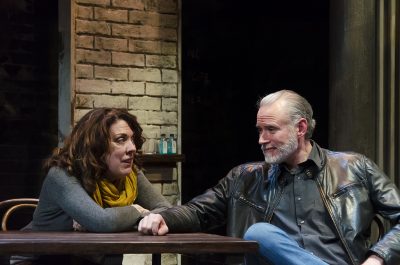
Playwright Leo McGann knows a thing or two about theatrical history. A native of Northern Ireland, he graduated from Oxford University in 2008 with a Bachelor of Arts in modern history and is currently enrolled in Boston University’s MFA Playwriting Program. A product of his studies and playwriting prowess, “The Honey Trap” — which runs from Feb. 16 to Feb. 26 at Boston Playwrights’ Theatre — is a thrilling portrait of human emotion through a historical lens of the not-so-distant past.
The premise of the play depends on several drastic twists and thrilling breakthroughs. To maintain the integrity of its mystery and status as a mind-bending exposé of emotional history, any plot synopsis is forced into ambiguity: two friends from the army meet an enticing pair of women at a bar. The outcome of that seemingly innocuous evening gone terribly awry is recounted 30 years later for an oral history project.
Even as the play begins, its intentions for development remain unclear, demanding a complete immersion into the world exposed therein to discover the answers to an infinity of questions. To provide any more information would be to intrude upon a gallery of revelations and rob the play of its exhilarating development.
The set alone offers opportunities for speculation. The moments of conversational buzz and a locating of seats, which precedes any theatrical production, offer a unique opportunity for the consideration of a simplistic yet unique set design before the more malleable components of dialogue and character are introduced in the opening scene. Marvelously intricate and simplistic at the same time, the set stimulates geniality and tension in a manner which penetrates the subconscious of viewers throughout the experience of the 105-minute, two-act run.
Dynamic components frequently slide, roll and hurtle across the stage throughout the production, while the corrugated metal and grimy brick walls seem to simultaneously bear the conspicuous smudges of the past and hide an infinitely massive bulk of the present unknown. Varied heights — aided by wooden platforms and bare-bones structural support — transform a small space of limited square footage into numerous environments which will be filled with personality, emptied of neutrality, and fundamentally transformed as the characters do the same.
Just as the visual and physically concrete elements of the set transmit a myriad of emotive possibility, the pervasive depth of each character grants the theatrics a forceful, expounding integration of sentimentality and angst against the backdrop of haunting uncertainty.
An aged, bearded and coarse Dave (Barlow Adamson) is provided a jigsaw of coping mechanisms and a jolting articulation of grief, guilt and dealing with the torture of recollection. He is a performance worthy of supreme accolades. In his interactions with other characters, as well as literal ghosts of his past, Adamson cultivates in Dave a penetratingly absorbing representation of the complexities of desperation. This is complemented by Conrad Sundqvist-Olmos’ portrayal of a morally confused Young Dave, and a haunting recurrence of his since-passed companion Bobby (Ben Swimmer). This introspective examination of Dave’s traumatic experience is the pinnacle of poignant theater.
In scenes of the present day, Dave’s multilayered psyche is further accentuated by two contrasts — that between him and an interviewer named Emily in the first half of the play, and that between him and a woman from his past, Sonia, in the second half.
Emily, an uptight and result-driven academic, is played to a tee by Grace Georgiadis, whose firm, terse dialect — the only character with an American accent in the play — is sharp and buttoned up. While Emily is no more than an independent academic on assignment, her increasingly driving questions and vocal sparring with Dave highlight his short fuse and paranoia, a likely consequence of the events he details in the interview. The question-answer format is expertly manipulated for the purpose of development in the play, and there is no doubt that the interrogative circumstances of Act One catalyze the intensity of Act Two.
Exponentially opposite are interactions between Dave and Sonia, who actress Maureen Keiller develops as an alluring representation of Dave’s unfulfilled desires and his incessant need for relief, information and solace from the enigmas of his past. Sonia is, in many ways, a resolution of Dave’s existential dilemmas. She grants him the outlets through which he proceeds to come to terms with his internalized conflicts, albeit with cliff-hanging effect in a gasp-inducing final scene.
In combination with stellar acting and a magnificently grungy set, McGann’s historically accurate and intricately emotional writing of “The Honey Trap” oozes complexity from the pores of the human condition. Deeply cathartic and penetratingly profound, its examination of the traumas of the past are an undeniably essential theatrical experience.














































































































